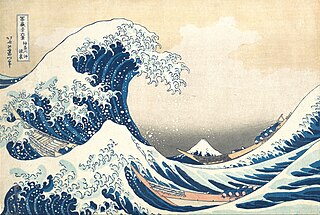Related Research Articles

Rinpa is one of the major historical schools of Japanese painting. It was created in 17th century Kyoto by Hon'ami Kōetsu (1558–1637) and Tawaraya Sōtatsu. Roughly fifty years later, the style was consolidated by brothers Ogata Kōrin (1658–1716) and Ogata Kenzan (1663–1743).

Hiroshi Yoshida was a 20th-century Japanese painter and woodblock printmaker. He is regarded as one of the greatest artists of the shin-hanga style, and is noted especially for his landscape prints. Yoshida travelled widely, and was particularly known for his images of non-Japanese subjects done in traditional Japanese woodblock style, including the Taj Mahal, the Swiss Alps, the Grand Canyon, and other National Parks in the United States.

Matsubara Naoko is a Japanese-Canadian artist.
Chizuko Yoshida was a Japanese modernist artist, whose work reflected the development of art in Japan following World War II. She was noted for providing a connective link between widespread modern art movements and traditional Japanese imagery.
Ayomi Yoshida is a Japanese artist, currently best known for her room-sized installations of woodchips that have been displayed in galleries and museums in Japan and the United States. Between 1979 and 1997, prior to creating installations, her main medium was woodblock printing.

Woodblock printing in Japan is a technique best known for its use in the ukiyo-e artistic genre of single sheets, but it was also used for printing books in the same period. Widely adopted in Japan during the Edo period (1603–1868) and similar to woodcut in Western printmaking in some regards, the mokuhanga technique differs in that it uses water-based inks—as opposed to western woodcut, which typically uses oil-based inks. The Japanese water-based inks provide a wide range of vivid colors, glazes, and transparency.

The Tokyo National Museum of Modern Art in Tokyo, Japan, is the foremost museum collecting and exhibiting modern Japanese art.
Daniel Kelly is an American artist based in Kyoto, Japan. Works primarily consist of original paintings and prints. Paintings usually begin with three-dimensional collage making incorporating materials that can be found in Japan such as tatami and bamboo mats. In printmaking Kelly primarily works with lithography and woodblock, often using chine-collé to incorporate materials such as antique Japanese book pages, ukiyo-e and calligraphy into his prints.

E-hon is the Japanese term for picture books. It may be applied in the general sense, or may refer specifically to a type of woodblock printed illustrated volume published in the Edo period (1603–1867).
Syoh Yoshida is a Japanese artist of the nihonga and ink painting genre.
Kobayashi Takao, known professionally as Kobayashi Keisei, is a Japanese printmaker, academic and artist specializing in hanga and wood engraving. He uses techniques, such as the composition of two wood plates called kagami-bari technique, which creates two mirrored symmetrical figures on both sides of washi paper. He is a professor at the Tama Art University, teaching printmaking. He is also a member of the Japan Print Association and a member of the Japan Artists Association, Inc..
Tenmyouya Hisashi is a Japanese contemporary artist.

Takahashi Shōtei (高橋松亭), born Hiroaki was a 20th-century Japanese woodblock artist in the shinsaku-hanga and later shin-hanga art movements.

Tetsuya Noda is a contemporary artist, printmaker and educator. He is widely considered to be Japan’s most important living print-artist, and one of the most successful contemporary print artists in the world. He is a professor emeritus of the Tokyo University of the Arts. Noda is most well-known for his visual autobiographical works done as a series of woodblock, print, and silkscreened diary entries that capture moments in daily life. His innovative method of printmaking involves photographs scanned through a mimeograph machine and then printed the images over the area previously printed by traditional woodblock print techniques onto the Japanese paper. Although this mixed-media technique is quite prosaic today, Noda was the first artist to initiate this breakthrough. Noda is the nephew of Hideo Noda an oil painter and muralist.

Keiko Minami was a Japanese artist, aquatint engraver, and poet. She is best known for her pictograph-like aquatints with a whimsical, childlike aesthetic.
Kojima Gyokuhō was a Japanese artist. Little is known about him, except that he worked with the Kyoto City publisher Happōdō. He rejected the Western concept that art was an expression of the artist's individuality. Rather, he embraced the traditional method of producing woodblock prints through the cooperation of a designer (artist), a woodblock carver, a printer, and a publisher. He also favored traditional Japanese subjects, such as Japanese textiles, kabuki, and ukiyo-e masterpieces.
Fujiko Shiraga was a Japanese avant-garde artist and one of the earliest female members of the Gutai Art Association. Active as an artist between the early 1950s and 1961, Shiraga was known for creating highly tactile artworks by pasting and creasing sheets of torn Japanese paper. Since last decade, Shiraga's works have received growing art-historical attention. Her paper works, paintings, and installations were featured in major Western exhibitions on Gutai art and two posthumous retrospectives.
Nancy Genn is an American artist living and working in Berkeley, California known for works in a variety of media, including paintings, bronze sculpture, printmaking, and handmade paper rooted in the Japanese washi paper making tradition. Her work explores geometric abstraction, non-objective form, and calligraphic mark making, and features light, landscape, water, and architecture motifs. She is influenced by her extensive travels, and Asian craft, aesthetics and spiritual traditions.
Ansei Uchima was an American artist and teacher primarily known as a sōsaku-hanga woodblock printmaker who employed traditional ukiyo-e Japanese techniques to produce abstract works covering a range of distinct personal styles.
Toshiko Uchima was a Japanese-American artist. She worked in a variety of media, including collage, box assemblage, oil paintings, woodblock prints and drawings.
References
- Art piece at British Museum
- Artelino.com
- TED Conference Sarah Brayer:
- Japanese Prints at the Verne collection, September 15, 2010:
- Franco, Betsy; Verne, Michael (1997), Quiet Elegance: Japan Through the Eyes of Nine American Artists, Tokyo: Tuttle, ISBN 0-8048-3126-2
- Japan Times:
- New York Times:
